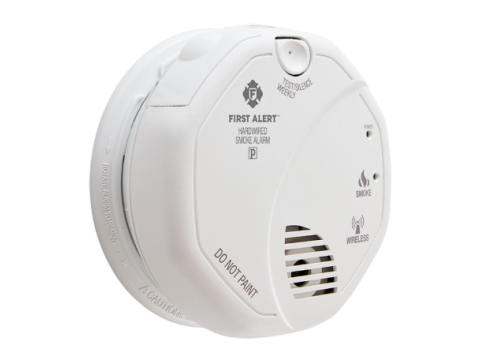An autonomous fire detector (often called a standalone smoke alarm) integrates a fire-detection sensor (commonly for smoke), battery power, signal processing electronics, and an audible alert (siren) into a single housing. These detectors, typically placed on ceilings, can provide a basic warning of a fire without needing a full, centrally monitored fire alarm system.
While widely praised for ease of installation and low cost, standalone alarms also present practical limitations in coverage area, loudness, and battery maintenance, potentially affecting their reliability. Below, we delve into how these devices work, their practical considerations, and guidelines for installing them effectively.
What Is an Autonomous Fire Detector?
A standalone fire detector’s purpose is to sense a factor indicative of fire (commonly smoke) and sound an internal siren if that factor exceeds a preset threshold. Unlike a full fire alarm system, it does not connect to a central panel nor activate building-wide safety measures. Instead, it only warns the occupants physically present and within earshot of the unit’s buzzer.
Typical Components
- Smoke Sensor (commonly photoelectric)
- Battery (9V or lithium)
- Signal Processor (small circuit board)
- Piezo Siren (audible alert)
- LED Indicator (visual status)
How Standalone Smoke Alarms Work
Smoke Detection
Most residential standalone alarms use photoelectric (optical) technology:
- Infrared (IR) LED and photodiode inside a labyrinth.
- In normal conditions, IR doesn’t reach the sensor.
- When smoke enters, it scatters IR light onto the photodiode, triggering an alarm if the intensity is above a threshold.
Battery & Alerts
- Battery powers the sensor and siren.
- A short beep every minute typically means low battery—replace it promptly.
- A continuous loud alarm suggests either:
- Actual smoke or
- Dust/clogging in the optical chamber (cleaning needed).
Volume & Range
- Manufacturers claim 85–120 dB at 1 meter. Realistically, many produce around 85 dB—akin to a kitchen blender.
- Sound may be inadequate for rooms farther away or closed behind multiple doors.
Pros & Cons of Autonomous Fire Detectors
Advantages
- Easy Installation
- Typically mounted on the ceiling with two screws (or adhesive) and powered by an onboard battery.
- No Wiring Needed
- Great for existing homes without dedicated alarm wiring.
- Low Initial Cost
- Basic units can start as low as $10–$30, though advanced or brand-name models may cost more.
Disadvantages
- Limited Volume
- Might not be heard throughout a larger home or in noisy environments.
- Offers little help if no one is there to respond.
- Battery Maintenance
- Must periodically replace or check the battery.
- Low battery alerts can beep at inconvenient times (often at night).
- No Remote Monitoring
- Cannot send signals to a central station or building system.
- Useless for remote notifications if you’re away from home.
- Dust Sensitivity
- The sensor can false-alarm if the optical chamber becomes excessively dusty or clogged.
Is a Standalone Smoke Alarm Required in Homes?
Regulatory Overview
- High-Rise Buildings: In many jurisdictions (e.g., structures over ~75 feet in the US, or 28 meters in some regions), a centrally monitored fire system is mandatory.
- Single-Family or Low-Rise Residences: Local codes often require basic smoke alarms in each bedroom and hallway. Many building codes specify hardwired or interconnected units, so all alarms sound if one triggers.
- Autonomous Alarms: Some older or smaller residences allow standalone battery units. They might be supplementary to a partial or no existing system.
Note: Requirements vary by state or city. Always consult local building and fire codes.
Installation Guidelines
Coverage & Spacing
- Each detector covers a certain floor area (often ~800 sq ft / 74 m² for typical 8 ft / 2.4 m ceilings).
- Large or multi-room spaces may require multiple detectors.
Placement
- Ceiling Mount is standard—ideally near the center of the room.
- Avoid corners, recessed areas, or behind large fixtures where airflow is minimal.
- Keep detectors away from kitchen steam or HVAC vents to reduce false alarms.
Ensuring Audibility
- The alarm must be audible in all bedrooms or sleeping areas.
- Additional units may be needed if the floor plan is large or multi-level.
Maintenance
- Dust cleaning: Gently vacuum or use compressed air to remove debris in the smoke chamber.
- Battery checks: Replace at least annually (or follow manufacturer instructions).
- Test regularly: Use the built-in test button monthly.
Limitations & Realistic Use Cases
- Apartment Use:
- If no building-wide system is installed, a standalone detector at least provides occupant-level warning.
- Not connected to the main building’s smoke control, elevator recall, or building alarm system.
- Second Homes or Small Workshops:
- Provide a basic local alert if someone is present to respond.
- When You’re Away:
- No remote notification—could reduce the actual benefits if fires start while unoccupied.
Conclusion
Autonomous (standalone) fire detectors, typically battery-powered smoke alarms, offer a basic, inexpensive layer of fire protection. They’re easy to install and operate independently, making them popular for retrofits or supplementary coverage. However, they have limited coverage (sound might not carry far), require battery upkeep, and cannot interface with building-wide systems or professional monitoring.
Key Takeaways:
- Simple Setup: No external wiring, suitable for older homes or quick installations.
- Battery Maintenance: Pay attention to low battery signals and replace promptly.
- Limited Alert Range: Enough for a room or small apartment; may not be heard in distant rooms.
- Dust & False Alarms: Clean periodically to reduce nuisance triggers.
For more robust protection—like multi-room coverage, remote alerts, or integration with sprinklers—consider interconnected or centrally monitored fire alarm solutions. If you need guidance on selecting or installing standalone vs. system-based detectors, visit safsale.com. Our experts can help you design a fire safety strategy that best fits your home or property.

